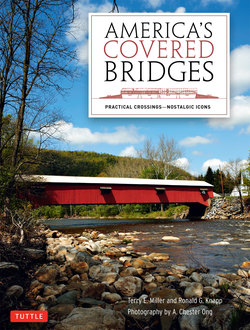Читать книгу America's Covered Bridges - Ronald G. Knapp - Страница 2
На сайте Литреса книга снята с продажи.
ОглавлениеHillsgrove, a hamlet nestled in Sullivan County, Pennsylvania’s Appalachian uplands, illustrates well the ephemeral character of timber bridges: the need for bridges to carry pedestrians, carriages, and railways; technological change and the replacement of materials; and the role of covered bridges in the “industrialization” of once heavily wooded areas. Constructed by Sadler Rogers in the 1850s, the wooden bridge on the left led directly into the settlement, while the taller railroad bridge brought timber-laden railcars to the odoriferous and polluting tannery, an industry that began in 1870 and lasted in Hillsgrove until 1924. As engines became larger, rail traffic increased, the industry flourished, and the wooden covered railway bridge was replaced by a “modern” iron truss bridge. Because tannin extracted from the bark of the bountiful hemlock trees in the area was used to produce leather from hides, a boom in population benefited this area. By 1890, 805 people inhabited Hillsgrove, but with the man-made development of acetone to replace tannin there was the following decline: 1900, 686; 1920, 273, and by 1930, 50 persons left. At the beginning of the twenty-first century, with a year-round population of about 70, the hamlet and surrounding area entice countless visitors to enjoy its reforested hillslopes, clean water, and fresh air. Branded as Pennsylvania’s Endless Mountains, locals take great pride in the three surviving covered bridges at Forksville, Hillsgrove, and Sonestown even as others are only recalled in memory and faded photographs. (Sullivan County Historical Society’s Museum)
